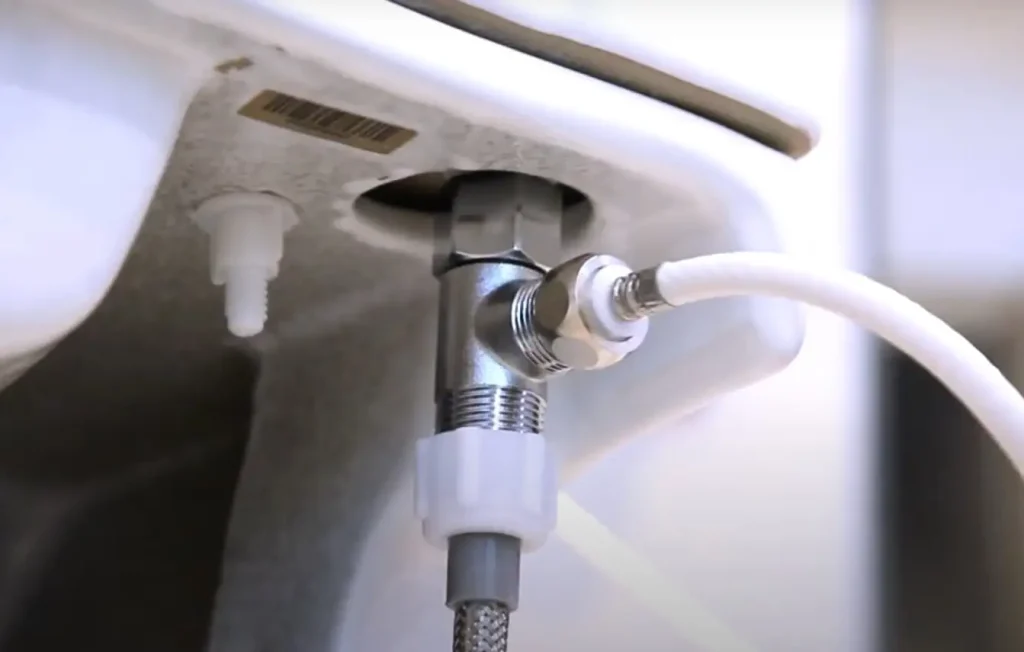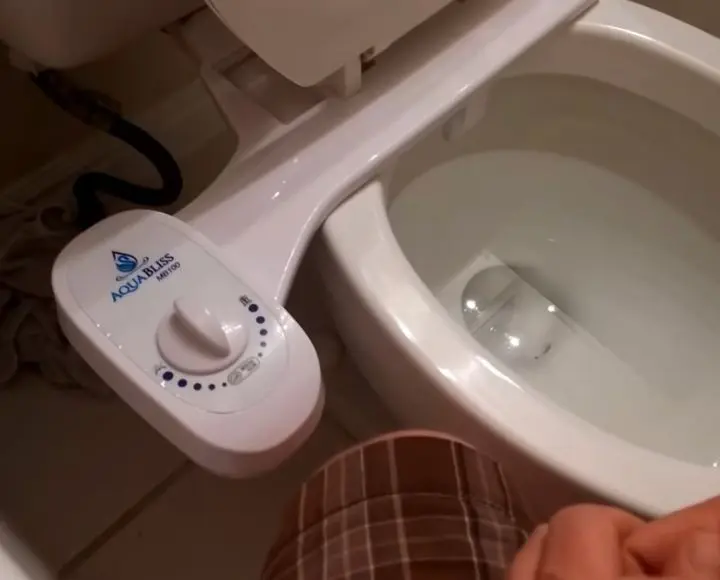There’s nothing worse than doing your business on the toilet and then for your bidet to not work properly. There are a few reasons why your bidet’s water pressure may be low, in this article we will take a look at some of the reasons, as well as their solutions.
The most common reasons for low water pressure are leaks and damage to the water lines, the shut-off valve not being fully open, a clogged filter, and the bidet’s pressure settings may be too low.
Truth be told, there’s a lot that could be wrong with your bidet, but don’t replace it just yet! Follow the steps listed in this article and hopefully, you will get it back up and running perfectly again.
Why is my Bidet’s Water Pressure too Low?
As mentioned before, there are many different reasons why your bidet’s water pressure may be too low.
It could be as simple as the pressure settings not being high enough, or you may have leaks in your water lines. Other causes may be your valves not being fully open or maybe you need to clean out or replace the filter.
In this article, we will cover as many of the common problems as possible, and try to solve them.
How to Increase Bidet Water Pressure
If your bidet’s water pressure is too low, you have to diagnose the problem before you can apply a fix. Follow the steps below to find out where your problem lies.
Check For Leaks
Since we are dealing with a water system, it is possible you have a leak or damage somewhere in your water lines. Before you continue to the next step, you should make sure there are no leaks, as this could end in catastrophe.
The easiest way to find any leaks would be to look for water on the floor. If there’s no water on the floor then you can try taking a piece of paper or a paper towel and running it along the hose and valves to see if the paper gets wet.
Fix the leak by replacing any broken parts. If you don’t find a leak, or if fixing the leak didn’t increase the water pressure, then there may be other problems.
Open the Toilet Shut-off Valve Fully
All toilets have a shut-off valve that regulates the water intake. If your bidet has a low water pressure then it may be caused by the shut-off valve not being fully opened.
First, you need to locate the shut-off valve. This may be different depending on your toilet but usually, it can be found at the bottom left of your toilet.
To increase the water pressure in your bidet you should make sure the shut-off valve is opened all the way.
Check if the Filter Needs Cleaning
Low water pressure can also be caused by a clogged filter. Most bidets have a mesh filter in the hose, this is there to filter any debris from coming through the water intake and clogging your nozzles.
Simply remove the hose and check the filter. You can clean it under running water, in some cases, you may have to replace it altogether.
There may also be other filters depending on the type of bidet you have. If you are running an external filter you should also make sure that it is working properly.
Check if the T-Valve is Fully Open
The T-valve is a valve that connects your bidet with the toilet’s main water supply. This valve can also be adjusted to allow for more water intake. Depending on your toilet and the bidet you are using, the T-valve may be situated in different places.
The first step is to locate the T-valve, it looks something like this:

Then you want to check and make sure it is fully open. This will allow for maximum water intake and should help increase your water pressure.
Check Your Bidets Pressure Setting
Most bidets come with some sort of pressure setting. Check the instructions to see if you have one for your bidet. The reason for low water pressure could simply be that your bidet’s pressure settings are set too low.
Check the manual for your specific make and model to learn more about how to increase the pressure settings.
Check the Water Supply to the Bidet
Bidets are connected to the main water supply in one way or another. You might have a bidet that connects to the water tank on your toilet, or it may connect directly to the water lines.
Check if there’s something blocking the water coming to your bidet. There could be dirt clogging the pipes, in which case you will have to clean the pipes.
Once the pipes are clean and there are no blockades your bidet should have higher water pressure.
If you are unable to clear out the pipes on your own, you might have to consult a professional. This can be costly, so unless you are sure there is a problem with the water supply, move on to the next step.
Check the Water Pressure in Your Home
Another possibility is that the water pressure in your home is too low. This is easy to spot as the water pressure in your sink will also be lower than expected.
There are a couple of things that could cause this to happen. Here are a few of the problems you might have:
- Bad pressure regulator – The pressure regulator in your house could be broken. This can result in both low and high water pressure.
- Clogged pipes – Clogged pipes will result in low water pressure. If you can’t clear the pipes yourself, I suggest you consult a professional.
- Old pipes – Pipes will corrode over time. Corroded pipes will not only lower the water pressure but also lower the quality of your water.
If the regulator is the problem, you can try adjusting the regulator and see if that helps. Simply tighten the screw and that should increase your water pressure.
Check if There are Any Water Issues in Your Area
Most often when there’s something wrong with the water in your area, you’ll get notified pretty quickly, sometimes even beforehand.
Let’s face it, this is probably not the reason why your bidet’s water pressure is low. However, it’s best to mention this in case you haven’t been notified of some maintenance on the water supply.
There’s also the possibility of an outage. This can be sudden and happens often during flooding and storms.
Contact the Manufacturer
After going through this article, trying everything, and still experiencing low water pressure in your bidet, it might be due to a faulty bidet. This is a perfectly good reason to return and replace your faulty bidet.
Most bidet manufacturers offer one or two years warranty on their products. Contact the manufacturer or store of purchase and ask for a replacement.
Why is my Bidet Not Spraying Water?
Perhaps your bidet won’t spray any water at all? What could be the cause of this? There may be a few different reasons for this and we will try our best to help you fix the problem.
If your bidet is not spraying water, make sure you have installed the seat properly. If that’s not the problem, try unplugging the bidet and then plugging it in again. If you are still having problems you should consult the manufacturer.
Make Sure the Bidet is Properly Installed
If you’re having trouble getting your bidet to spray water, the first thing you should check is the installation. Make sure that the bidet is properly installed according to the manufacturer’s instructions, also check that all of the hose connections are secure.
Unplug and Replug the Bidet
If the bidet is properly installed and it still won’t spray any water, try unplugging the bidet for 30 seconds and replugging it again. This will reset the system and should make it work again.
This step is only relevant for electric bidets, so if you have a non-electric bidet, keep reading.
Trigger the Seat Occupied Sensor
Most bidets have a sensor that registers when someone is seated on the bidet. The sensor is located on the seat itself, either in the front or on the side.
Most models have a skin sensor located in the 4-5 o’clock area of the seat. Grab a few pieces of paper or a paper towel, get it nice and wet, and place it on the sensor area.
This should activate the bidet and you should hear water dripping through the nozzle. If not, then there may be a serious problem with your unit.
Contact the Manufacturer
If none of the above-mentioned steps worked, then you should contact the manufacturer. Sometimes it’s as simple as you’ve got a faulty unit.
Most bidets come with a one or two-year warranty, so you should be able to replace the faulty unit free of charge.
What if the Bidet Water Pressure is too High?
What if your bidet’s water pressure is too high? That’s also a common problem people are having with their bidets. However, compared to the water pressure being too low, high water pressure is a whole lot easier to fix.
At least you won’t have to worry about leaks, clogged pipes, or a faulty bidet. Here are a few ways to adjust and lower your bidet’s water pressure.
Partially Close the Toilet Shut-off Valve
The shut-off valve is often located at the bottom left of your toilet. This valve is what’s feeding the water to your toilet’s water tank, and often to the bidet as well. If the shut-off valve is fully open, try closing it partially and the pressure should go down.
However, don’t close it too much as this will cause your entire toilet to have low water pressure. Don’t close the shut-off valve if your bidet does not connect to your toilet’s main water source.
Check and Adjust the T-Valve
If your bidet’s water pressure is too high, you should check and adjust the T-valve. This is the valve that connects your bidet with your toilet’s water supply.
First, you have to locate the T-valve, simply follow the hose from the bidet and you should be able to spot it pretty easily.
Then you have to turn the T-valve slightly to the left. This will partially close the valve, resulting in lower water pressure. In some cases, you will have to loosen a nut that is protecting the valve handle. Simply use a wrench to loosen it.
If you’re unsure how you should adjust the T-valve, check the instructions that came with your bidet.
Adjust the Pressure Settings
Sometimes you just have to adjust the pressure settings of your bidet. Not all bidets are the same, so it’s best to consult your bidet’s manual to figure out how to lower the water pressure settings.
Conclusion
There could be many different reasons why your bidet water pressure is too low, in this article we’ve tried to cover the most common problems. I hope you’ve found this article helpful and that you were able to locate the problem and apply a fix.
Some of the most common problems are:
- Leaks and damage in the water lines.
- The T-valve not being fully open.
- The Shut-off valve not being fully open.
- Your bidet pressure settings are being set too low.
- A faulty bidet.
In case you have a leak or problem with your water lines, you best consult a professional plumber. You should not be doing any plumbing yourself if you are not experienced, as it could end in a disaster.
